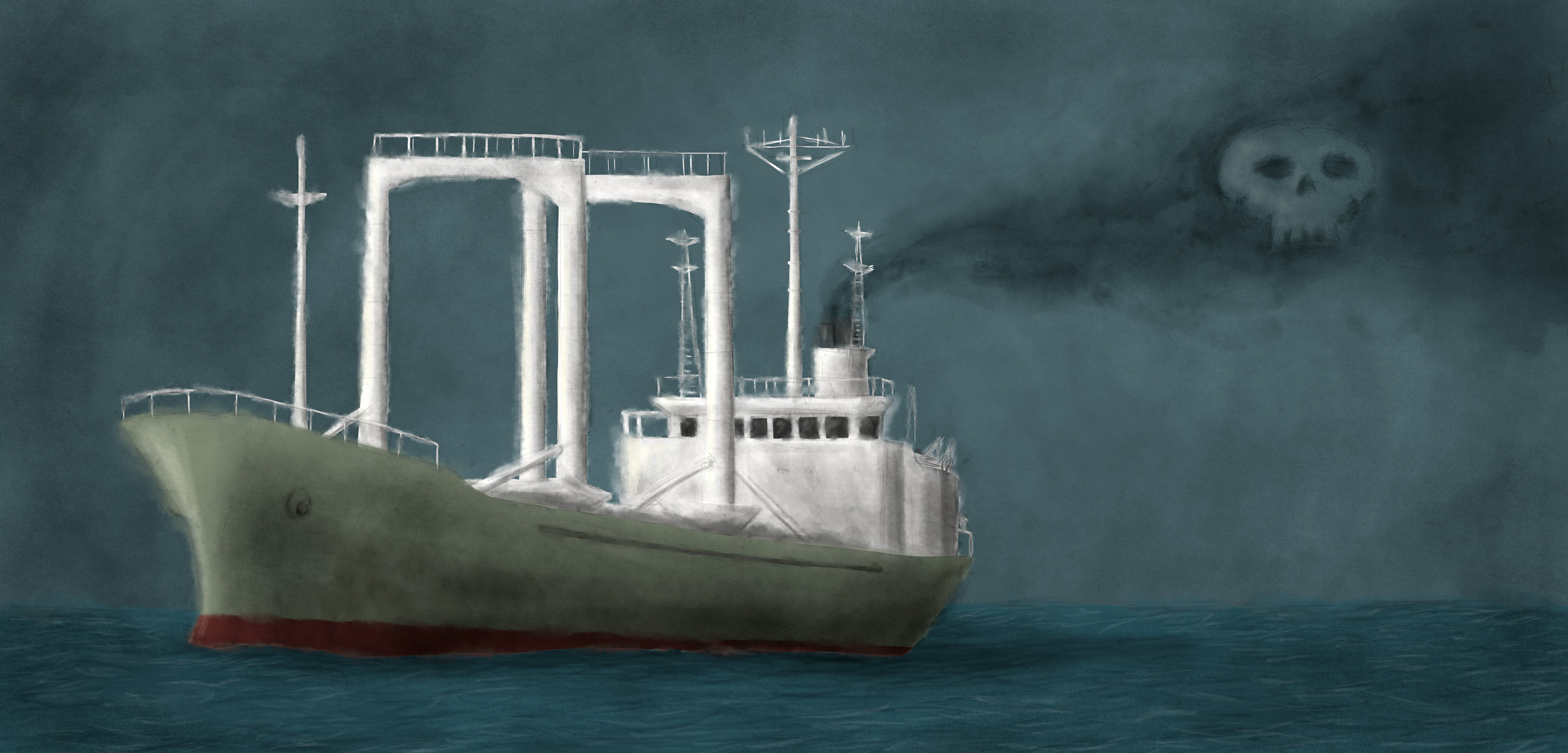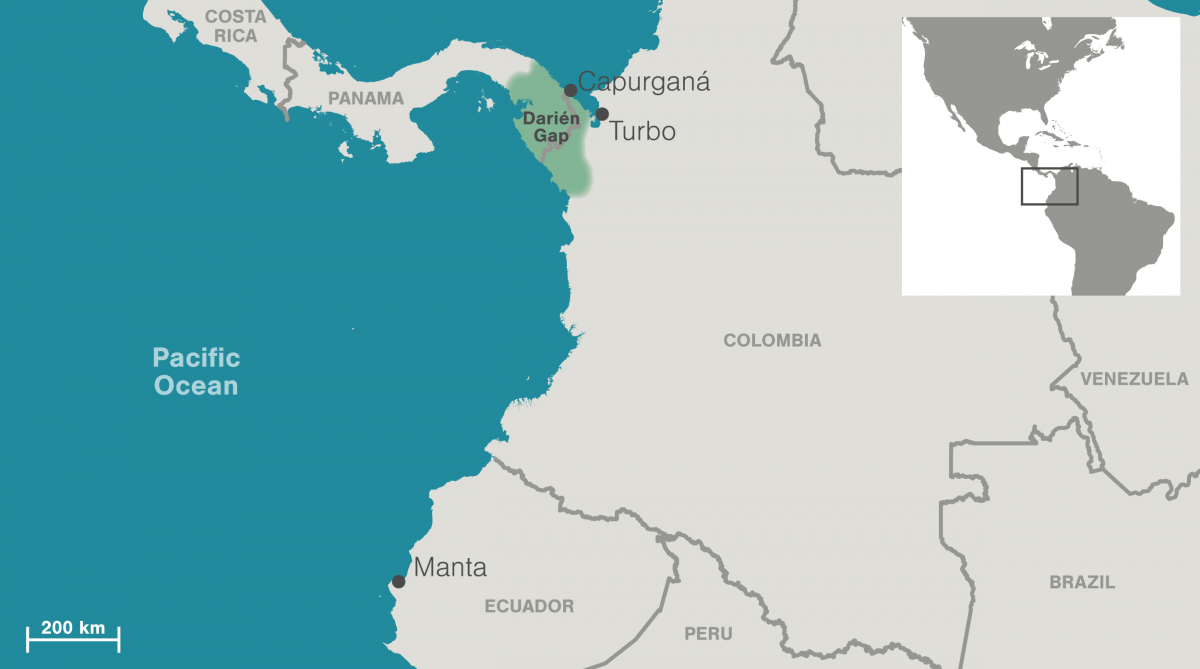Searching for Keith
A detective’s quest reveals how one idealistic fisheries observer may have collided with criminals and desperate migrants—and paid for it with his life.
Article body copy
Congratulations to Sarah Tory on winning two Canadian Online Publishing Awards for this article.
Long before Karsten von Hoesslin first heard the name Keith Davis, before he spent countless unpaid hours tugging at investigative threads and careening into dead ends as he searched for answers about the man’s strange disappearance from a fishing vessel, before he jetted to South America chasing clues, he dedicated his days to dealing with a different sort of challenge—pirates.
Von Hoesslin, a Canadian with a background in hostage and hijacking negotiation, worked for a European marine consulting firm, responding to piracy cases on the Indian Ocean and South China Sea. But he was always drawn to the mystery of cold cases, so in 2016, after a decade in the field, he gave up high-stakes ransom transfers to pursue independent detective work.
His first case, which he funded with his own savings, was a 2012 mass murder of as many as 34 fishermen in the Indian Ocean. Few detectives confront such complicated cases, but von Hoesslin was vexed by the fact that the perpetrator had gone unpunished.
National Geographic learned about his work and made a reality television series about his efforts, following von Hoesslin as he tracked down witnesses and suspects. He had hoped the show’s producers would help solve the case. Instead, they chastised him: “Remember, it’s not an investigation; it’s a TV show.”
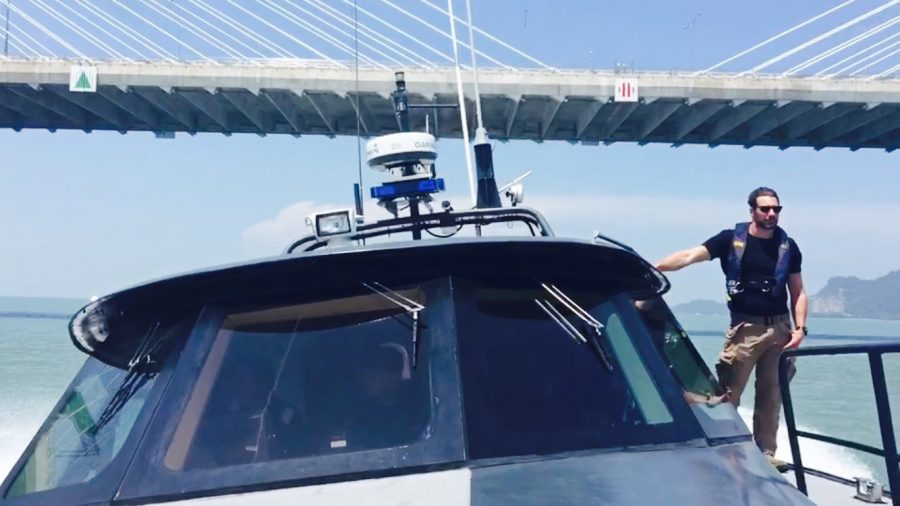
Independent detective, Karsten von Hoesslin, photographed in 2016 during an anti-poaching operation in Malaysia, has been looking for answers about Keith Davis’s disappearance for more than two years. Photo courtesy of Karsten von Hoesslin
When the show, Lawless Oceans, ended, von Hoesslin continued investigating on his own. He found the Chinese captain responsible for the murders and got a confession by pretending to interview him for a job. The detective notified the Chinese authorities, but no arrest was ever made.
Frustrated, von Hoesslin contemplated a career shift. He moved from England, where he had been based, back to Canada to pursue his other passions: stand-up paddleboarding, trail running, backcountry skiing, and search and rescue work with his dog, an adventurous Hungarian vizsla named Delphin. But he could not stop thinking about Keith Davis.
Davis, a fisheries observer originally from Arizona, had been working on the high seas aboard a tuna transshipment vessel—a ship that collects catches from fishing boats and ferries them to port, saving the boats a long trip to shore. As an observer, his job was to independently monitor the catches and collect data from tuna transfers. He was on deck, watching the crew prepare to hoist loads of tuna into the ship’s hold, just before he went missing on a calm September 2015 day in the eastern Pacific at the age of 40.
In the years before he went missing, the observer had become increasingly preoccupied with the lawlessness he saw on the world’s oceans—and the dangers encountered by observers, who sometimes face hostility from captains and crews. He tried repeatedly to convince fisheries managers to pay attention and implement changes that would strengthen observer safety, with little success. Almost no one who knew Davis and understands the ruthlessness observers sometimes face believes his disappearance was an accident.
Nearly two years after Davis went missing, I wrote a story about his unsolved case. Von Hoesslin read it and got in touch. In June 2017, we met at a coffee shop in downtown Toronto. Tall, with an athletic build, he wore Ray-Ban sunglasses and had a well-trimmed beard flecked with gray. Davis’s family had recently contacted him to ask if he would investigate on their behalf, and he had agreed. For von Hoesslin, who has two dominant modes—earnest and earnestly outraged—Davis’s case felt almost personal. The two were around the same age, they loved traveling and adventure, and they shared a similar sense of indignation over injustice in the world. In Davis, von Hoesslin saw a version of himself: one person trying tirelessly to make a difference, even when confronted with a wall of corruption and bureaucracy. “I really respect that, and that’s why I think Keith’s case deserves the attention it needs to be solved,” he said.
Davis’s family and friends had agonized over his disappearance, waiting for answers from the authorities that never came. Under maritime law, Panama was in charge of the investigation because that was where the Victoria 168, the boat Davis vanished from, was registered. After searching the surrounding ocean for Davis with the help of other boats in the area, the Victoria 168 returned to Panama where authorities searched it and conducted interviews. But the final report was inconclusive.
Von Hoesslin knew this: on the ocean, you can make almost anything disappear.
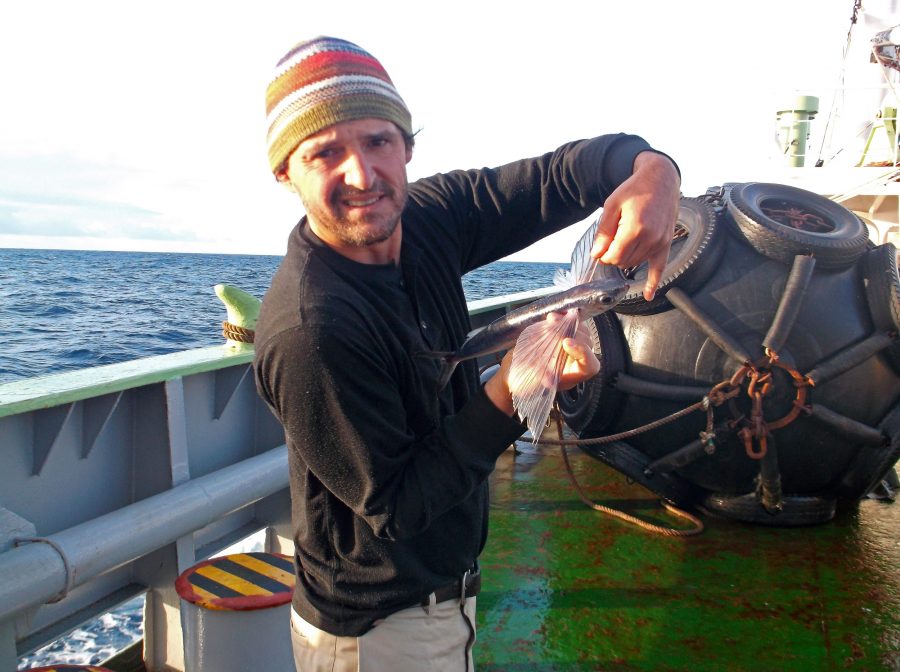
Keith Davis holds a fish up to the camera during his final weeks onboard the Victoria 168. Photo courtesy of John Davis
After he met with Davis’s family in Concho, Arizona, he began making inquiries. Red flags appeared everywhere in the Panamanian investigation: evidence overlooked or ignored, questions not asked, lines of inquiry not pursued. Panama’s Department of Maritime Accident Investigations had led the charge, but the majority of their cases are accidents at sea—spills, sinkings, collisions—and investigators are not trained in criminal or forensic work.
Of particular interest to von Hoesslin were two Chinese passengers whom Davis had photographed boarding the Victoria 168 at sea on August 29, 2015. They had come aboard via a supply crane from a longliner called the Chung Kuo No. 86. Both ships were owned by the same Taiwanese company, Gilontas. The crew list that von Hoesslin obtained indicated that the two Chinese passengers boarded separately, two days apart—on August 25 and August 27. Most of the crew members were Indonesian, so these men were anomalies. Who were they and why did the ship captain’s crew list lie about when they boarded the Victoria 168? No one involved with the investigation had ever inquired about or interviewed the men.
There was also the question of missing dan buoys—inflatable markers loaded with weights that were always on board the Victoria 168, but which the observer who replaced Davis noticed were absent from their usual storage spot. He saw that the weights from the weight bench, located right outside Davis’s cabin, were also missing. Those weights, von Hoesslin noted, would have been ideal for sinking a body at sea. But when von Hoesslin spoke to the lead investigator from Panama, Rafael Carrera, he told him that no foul play was detected and all they could conclude was that Davis’s disappearance was the result of an accident. Meanwhile, items that Davis would have worn on deck—hat, sunglasses, and work boots—were in his cabin, making the Panamanian authorities’ assumption that he had fallen overboard even more unlikely.
If Davis had feared for his life, he would have had no way of signaling that to the outside world. His only option for communication was using the captain’s email account, which was monitored by both the captain and Gilontas.
Von Hoesslin obtained Davis’s personal laptop from the observer’s father and discovered evidence that suggested Davis had been documenting things on board the vessel that he wanted to keep hidden. Embedded deep in Davis’s folders, von Hoesslin found photos kept separate from his observer assignments: one taken on August 19, 2015, was of the back of what appears to be a woman on board the Chung Kuo No. 86, which was moored next to the Victoria 168 at sea. She was clad in jeans and sparkly sandals and was standing at the railing watching some workers on deck while one of the Chinese passengers stood off to one side looking up at Davis’s camera angrily.
The other photograph was of a woman holding onto the guardrails of a second nearby Gilontas boat, the Chung Kuo No. 88, at night. “You could tell he was trying to take it inconspicuously,” von Hoesslin says. “It wasn’t full frame, it was blurry. It looks like it was taken hastily.” Davis took that photo from the Victoria 168’s deck five days before he disappeared on September 10. According to the crew lists, there were no women aboard either Chung Kuo boat. Women almost never work on tuna boats in the Pacific—either as captains or crew. So, who were they? And why had Davis left his cabin in the darkness to photograph one of them?
The more von Hoesslin prodded, the more he suspected that the photos Davis took of the women on board the Chung Kuo boats were somehow linked to why the observer went missing. But what began as a quest to solve the mystery of Davis’s disappearance at sea led von Hoesslin to something much larger—evidence of a human smuggling network reaching from Asia to the Americas. Someone or some people, von Hoesslin believed, knew that the observer had discovered that the boats were carrying more than just fish and had been keen to silence him.
In May 2018, von Hoesslin compiled his initial findings in a report and sent it to US federal agencies: “It is my suspicion that Keith Davis was murdered by the two passengers who were never questioned in the investigation,” he wrote, in reference to the Chinese men.
Then he went looking for answers.
In the port of Manta, Ecuador, in summer 2018, von Hoesslin watches men haul massive tuna up from the dock at the harbor, unloading catches from small fishing boats, or lanchas, under a low gray sky. The port reminds him of other ports he’s snooped around, mostly in Southeast Asia—places where a lot happens under the surface.
At night, lights flicker across the harbor where longliners and purse seiners are moored, and von Hoesslin wonders aloud about what else might have happened on those boats out there in the vast stretch of ocean between here and Tahiti. He’s come to Manta, the “tuna capital of the world,” hoping to figure out whether fishing boats like the one Davis disappeared from are bringing migrants from Asia to Ecuador as crew or as secret passengers. I came along to get a better understanding of what might have happened to Davis through von Hoesslin’s quest to solve the mystery.
Almost three years ago, the Victoria 168 landed here, after stopping in Panama, to unload its tuna. It was September 30, 2015, two weeks after Davis went missing, and officials from the FBI and US Coast Guard who had been alerted about the observer’s disappearance stood by, watching the boat unload as part of the official investigation. They found nothing out of the ordinary. If anything illicit had happened, the evidence was likely far behind, in the middle of the ocean, below the waves.
Aside from collecting data from fishing vessels’ catches, it had also been Davis’s job to look out for rule violations—from catching endangered species to dumping waste overboard. Many transgressions involved illegal, unreported, and unregulated (IUU) fishing—a rampant problem in the global fishing industry that can mean huge payouts for the captain and crew. But Davis was deeply troubled by much more than fishing-related violations. He had witnessed a culture of impunity on the high seas that had pushed him to speak out a few years prior at an observers’ conference about a likely human smuggling or trafficking operation on board a fishing vessel he was assigned to. He had the evidence—a video he had taken showing a hallway full of men sleeping side by side inside the boat. But some managers waved away his concerns, calling it evidence of a crew transfer, and another attendee cautioned him to “be careful” about speaking out. Like almost all fisheries observers, on the boats he had no protection from people who might have felt threatened by his presence.
IUU fishing is often just the tip of the iceberg, explains Mark P. Lagon, a former US ambassador at large to combat human trafficking. Financial incentives combined with a lack of enforcement on the oceans inspires some companies to overfish and exploit workers. On occasion, fishing vessels also ferry drugs or weapons and smuggle extra people on board.
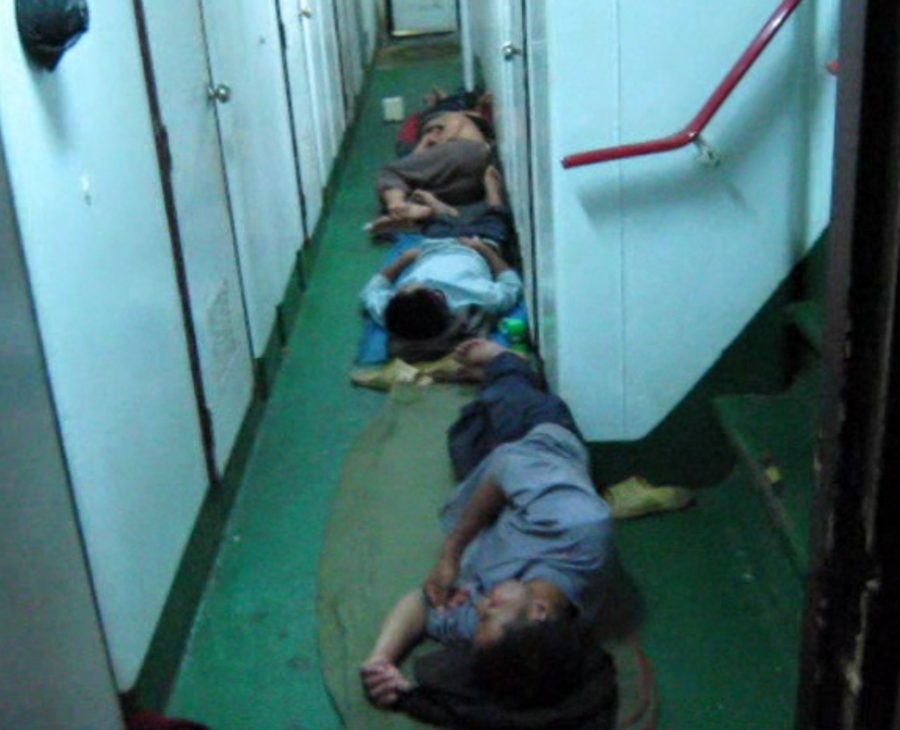
This is a single frame from a video captured by Davis a few years before his disappearance that shows a boat’s hallways crammed full of extra people—possibly migrants or forced laborers. Photo by Keith Davis
Officially, there’s a distinction between the smuggling and trafficking of humans: smuggling means moving people illicitly across borders and trafficking amounts to exploitation with the victims losing their autonomy. Undocumented migrants are among the most susceptible trafficking victims; they might hire someone to smuggle them across a border, only to end up conscripted into sex work or forced into labor.
Once the Victoria 168 had collected enough tuna from fishing boats such as the Chung Kuo boats, it would travel to port, leaving the smaller vessels to continue netting fish. It made regular stops in Manta, a known stepping stone for migrants seeking an alternative way to sneak into the United States—generally poor migrants who are routinely denied tourist visas or can’t afford the school tuition that would give them access to student visas.
Ecuador has a long history with homegrown smuggling networks. For decades, smugglers, known colloquially as coyotes, have facilitated underground migration to the United States, says Soledad Álvarez, an Ecuadorian migration researcher. During the 1990s and early 2000s, the US Coast Guard used a US military base in Manta to intercept thousands of migrants leaving Ecuadorian shores in fishing vessels heading north to Central America and Mexico as part of a smuggling route to the United States. Coast guard vessels would sometimes torpedo fishing boats and sink them at sea. Some of the vessels were smuggling migrants, while others were simply fishing. The tactics caused public outcry and eventually led to the closure of the military base.
Meanwhile, under Ecuador’s then-president Rafael Correa, the country adopted a new constitution in 2008, offering universal citizenship and promoting the rights of migrants. As part of Correa’s support for free movement, he announced that anyone could visit Ecuador without a tourist visa for 90 days, a move he billed as a campaign “to dismantle that 20th-century invention of passports and visas.”
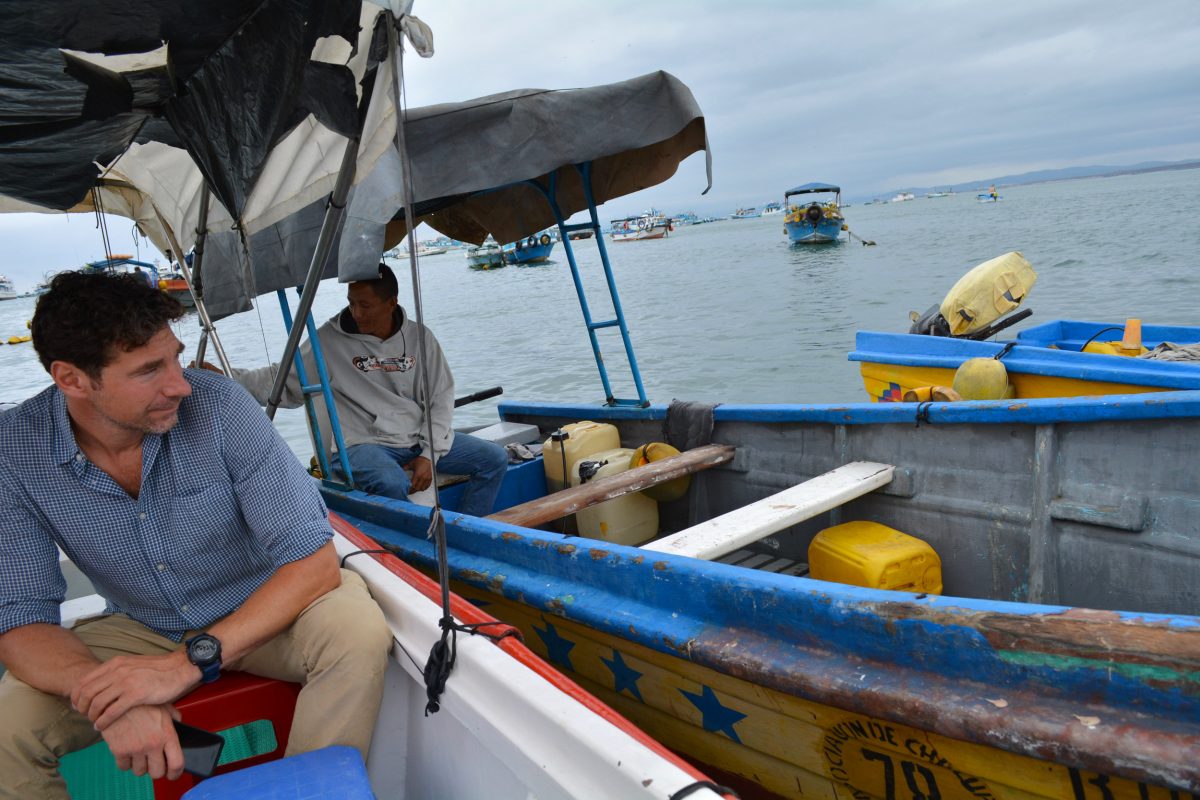
Von Hoesslin tours the harbor of Manta, Ecuador, as he searches for clues about an international human smuggling network. Photo by Sarah Tory
Travelers from China made up one of the largest groups of people to seize the opportunity; between June and October of that year, more than 10,000 Chinese entered Ecuador, more than twice the number in 2007. The influx of Chinese along with a more than 300 percent increase in South Asians entering Ecuador between 2008 and 2009 prompted Correa to revise his policy. He reinstated mandatory tourist visas for a number of African and Asian countries and stipulated that Chinese visitors must use a licensed tour operator and provide documentation of their trip.
Still, it’s easy enough for migrants transiting through the country to obtain fraudulent documents to work around the restrictions. A 2008 memo from the US embassy in Costa Rica described Costa Rican officials’ concerns that an organized fraud ring was smuggling or trafficking Chinese migrants through Ecuador into Costa Rica with the United States as their final destination. Or that such a ring was arranging valid residencies for individuals in China, but then using the documents for imposters waiting in Ecuador.
The presence of migrants funneling through Ecuador ties into one of the enigmas surrounding Davis’s disappearance: the photos of the women on his computer. Why, von Hoesslin wanted to know, had the boats concealed their presence?
One place he thought he might find clues was the shipping agency for the Victoria 168, a company called Atlas Marine with offices in Guayaquil and Manta. Manuel Cruz, the shipping agent, greets us inside a drab office, the hum of the air conditioner drowning out the sound of Manta’s traffic outside. Cruz has close-cropped hair that’s slicked back and wears a shirt unbuttoned at the top, revealing a gold chain with a cross. Von Hoesslin, conscious of the sensitivity of Davis’s disappearance, initially skirts the subject and instead inquires about what shipping agents do and whether Atlas Marine has noticed an uptick in business from China. Shipping agents, Cruz explains, are responsible for arranging the logistics for a boat in port. He shows us crew lists and supply inventories but grows increasingly suspicious of von Hoesslin’s questions.
“I heard a story about reefers, that there’s a lot of smuggling,” von Hoesslin says, using an alternative name for a transshipment vessel. “Have you ever heard of that?”
“No,” he says.
Von Hoesslin tries again. “Do many of the longliners have passengers or carry passengers in addition to the captain, the chief engineer, the crew?”
Cruz sighs, impatience creeping into his voice. No, he replies, the boats are too small. Finally von Hoesslin cuts to the chase. A fisheries observer was murdered on a longliner off the coast of Ecuador, he says. “The rumor is that he saw something. What do you think he saw?”
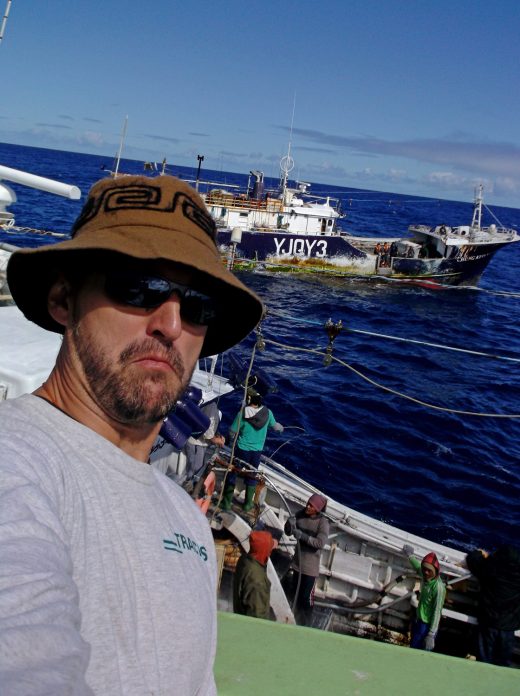
Davis took this image in 2015, during his final deployment onboard the Victoria 168. Photo courtesy of John Davis
Cruz stiffens when von Hoesslin mentions Keith Davis’s name. “Okay, I’ll tell you guys what I know,” he says.
The boat was in a stretch of the Pacific between Ecuador and Peru, Cruz says. He received an email a few hours after Davis went missing from the captain alerting Cruz that no one aboard the ship could locate the observer. “We think he might have fallen overboard,” it read. Later, when the Victoria 168 arrived in Manta, the captain told the shipping agent that Davis was a very quiet, reserved guy who drank a lot.
“My opinion [is] it was an accident,” says Cruz. “He went out of his cabin after drinking, slipped, and fell overboard.”
Von Hoesslin hides his skepticism. Observers are prohibited from drinking alcohol at sea —it would have been wildly out of character for Davis to break that rule. Back out on the street, von Hoesslin sends a text to another observer, Michael Gauthier, who knew Davis and worked aboard the Victoria 168.
“I don’t think Keith was the type to drink to excess if he even drank at all,” Gauthier replies. “Definitely doesn’t fit with what I know. … If Captain says [so] I would guess he’s lying, probably to deflect possible blame.”
Von Hoesslin hoped to use this trip to Manta to investigate his theory about a human smuggling operation from Asia to South America aboard the fishing vessels that Davis was observing, but finding people willing to talk is almost as difficult as finding the specialty espressos he goes in search of every morning.
After a series of dead ends, an Ecuador-based journalist we hired to assist us finds an official who will give us an interview: Carlos Nivela Bajaña, a captain in the Ecuadorian navy overseeing the port of Manta. His office has large windows overlooking the city and the gray sea and skies that make his starched white uniform appear exceptionally bright. Everything is neat and orderly, and ensconced in officialdom, like the PowerPoint presentation he insists on dictating to us before we ask any questions. He has printed off the slides and reads through bullet points and stats that support his stance: there is no human smuggling occurring on any of the fishing vessels because everyone on board must, by law, be registered—as if the very existence of procedures and rules eliminates any possibility of lawbreaking. “The important thing is that everyone on the boats is registered and their registration is verified by port officials,” he tells us in Spanish, referring to the crew list, which is intended to document all people on board and must be submitted to the port. “If there’s a person who’s not registered, the boat is sanctioned.”
Von Hoesslin is unconvinced. Remember, he says when we leave, “The officials only tell one story.”

Carlos Nivela Bajaña oversees the port in Manta, Ecuador, and denies the possibility of undocumented migrants sneaking ashore from ships. Photo by Sarah Tory
The next day, we try a different avenue. We’ve heard that Chinese—or Chifa—restaurants in Ecuadorian cities have been known to serve as clandestine smuggling hubs for Chinese migrants. The Chifa Yu restaurant is empty when we walk in around noon and are greeted by the owner, a woman named Sing (she declines to tell us her last name), who ushers us to a table near the front window. We order steaming bowls of wonton soup and begin chatting with Sing. She seems lonely and keeps bringing out more food—homemade jelly rolls, green tea, and a heaping plate of fried rice—but grows wary when we inquire about an immigration raid that took place at the port 10 years ago. Immigration authorities called her husband to serve as a translator for a group of Chinese migrants discovered in a fishing boat. There were 27 that day, Sing said, but she couldn’t give many details—none of the migrants would speak to her husband, so he didn’t find out much.
It’s just a thread of a story, but the thread matches another thread we hear the next day from a police officer who asks us not to use his name. As planned, we meet him on the curb outside the police station in downtown Manta, but he doesn’t want to talk in his office. We take a cab to a shopping center where we find a coffee shop and tuck ourselves into a booth at the back. The officer, who transferred here from Quito, Ecuador’s capital city 400 kilometers to the northeast, hesitates, yet another part of him seems eager to share what he’s been hiding for years—details of a case that was never solved; justice that never occurred.
A decade ago, he had been assigned to a case in Quito involving a Chinese man who was assassinated, his body discovered in his apartment, which also contained a briefcase full of forged passports and other documents. The dead man had close ties to the Ecuadorian government. But before the case could be resolved, corrupt public prosecutors shelved it.
He kept a few of the original documents, hoping that one day he might have a chance to return to the case, and he agrees to show them to us. The next day we meet him at a tattoo parlor, and he disappears into a back room. A few minutes later, he re-emerges and pulls out the documents on a table in front of us: a sheet of paper filled with various passport stamps, another filled with Chinese passport numbers, and a ledger with names and dollar amounts written beside them. He seems nervous and quickly puts the documents away. With smuggling operations increasingly orchestrated by criminal groups, his reticence is understandable.
Years before Davis disappeared from the Victoria 168, von Hoesslin was in Fiji for another assignment and first heard reports of Chinese migrants traveling across the Pacific to Ecuador on fishing vessels. Later, on a different trip to Asia, both a Taiwanese priest and a source who worked in the fishing industry confirmed that Chinese passengers were being transported aboard fishing boats by posing as crew. It’s likely that fishing vessels from Taiwan and China transport the migrants part way, to a zone in the ocean where international fishing territories overlap, and then offload them onto vessels bound for Ecuadorian waters.
The reports from the priest and the fishing industry source helped forge von Hoesslin’s theory about what Davis might have stumbled upon aboard the Victoria 168. Later, I ask David Kyle, an expert on migration at the University of California, Davis, whether this sort of operation is plausible. He explains that the majority of migrants using Ecuador as a launch point to travel north now arrive by plane, although once a smuggling route has been established, it never entirely goes away. It’s likely that a portion of poor Chinese migrants ineligible for business, tourist, or student visas but intent on reaching the United States still travel across the Pacific by fishing vessel.
For von Hoesslin, the stories from Sing and the officer help confirm part of his theory: Chinese migrants have been coming into Ecuador—some of them by boat—and then using forged passports to move north. He suspects that the women in Davis’s photographs were being transported illegally from somewhere in Asia on the Gilontas fishing boats, and that the mystery male passengers were involved. Now he wants to know how the women might have traveled across the rest of the Americas to their real destination.
Little is known about the intricacies of the smuggling organizations moving migrants through the Americas to the United States. Brazil and Ecuador—both with lax visa requirements—are the most common launch points, though smuggling networks designed to funnel migrants into the United States crisscross all of Latin America. Last December in Chile, for example, officials with Interpol uncovered US-bound migrants from Bangladesh posing as crew members of a shipping company in order to obtain temporary visas after smugglers provided them with fake working papers and ship documentation.
But there is one place where many of the networks emerge—a choke point of sorts for migrants traveling north—a swath of dense, roadless, and largely lawless rainforest between Colombia and Panama called the Darién Gap that most migrants traverse by foot.
If the fishing boats that Davis was monitoring from the Victoria 168 were smuggling migrants from Asia to Ecuador, it’s likely that the migrants then continued north, across the Ecuador-Colombia border, all the way up to Turbo, a ramshackle Colombian port city along the Caribbean Sea’s Golfo de Urabá, on their way to the gap.
By day, the air in Turbo is heavy with the heat of the tropics; streets buzz with blaring music, motorcycle engines, and exposed electrical wires; people of all ages gripping frayed backpacks walk along streets of cracked asphalt, past budget hotels, food carts, and cantinas. Every morning, the port is crowded with people buying tickets to villages up the Colombian coast, accessible only by boat, where secluded beaches lined with turquoise water and palm trees beckon.
The port city of Turbo, Colombia, is a key stepping stone for migrants journeying up the Americas to the United States border. Video by Sarah Tory
Von Hoesslin came here looking for reports of Chinese migrants, but we hear of migrants from all over the world instead—Cuba, Haiti, India, Bangladesh, Nepal, Congo, Cameroon, Ghana—almost all of them bound for the United States. In 2016, nearly 40,000 migrants, the majority from Haiti and Cuba, entered Turbo on their way to Panama. Many had salvoconductos, multiday transit visas that allowed them to pass through Turbo legally. With a visa, travelers could buy a legitimate ticket to Capurganá, Colombia, a two- to three-hour boat ride up the coast and the gateway town to the Darién Gap. After local officials stopped issuing the visas in 2017, the number of migrants documented leaving Turbo by boat dropped to a little over 6,000—but the true number is impossible to know as many more people could be departing secretly, without authorization.
As countries around the world have reinforced their borders and increased restrictions on legal migration, more and more migrants and refugees looking to escape violence or improve their economic circumstances have turned to smugglers who can help them cross borders undetected. Many of them have been coerced into the journey by smugglers who actively recruit customers while doling out misinformation. For instance, smugglers often spread ideas that underground migration is cheaper and easier than doing it legally and then charge migrants tens of thousands of dollars to arrange their journeys, depending on the distance, number of border crossings, use of fraudulent identity documents, and associated risks, among other factors. Often the fees are not fixed in advance and change according to migrants’ perceived wealth and conditions that arise along the route, such as an increase in border security.
Meanwhile, smugglers have become more organized and tech-savvy; for instance, loading GPS coordinates onto migrants’ phones and sending them alone on more dangerous routes to circumvent authorities.
Migrants who leave Turbo’s harbor for Capurganá travel up the coast by night in a small skiff. Waves routinely pummel the boat, soaking everyone on board. Many of the travelers cannot swim, but the coyote often deposits them in shallow water near the shoreline of Capurganá, leaving them to wade through the crashing waves onto white-sand beaches that are filled with sunbathers by day.
From Capurganá, the migrants find another coyote, often set up in advance through a primary smuggler who arranged the whole journey, to take them on a five- to 10-day trek through the jungle and across the border into Panama, eventually reaching Yaviza, the last outpost on the Pan-American Highway before it peters out into the heart of the Darién Gap. The alternative route—less arduous but more expensive—involves hiring another boat in Capurganá and traveling farther up the coast past the village of Zapzurro and into Panamanian waters.
Some migrants never make it. In Turbo’s main cemetery, there are at least 13 bodies buried in unnamed graves marked with the letters CNI, cuerpos no-identificados—unidentified casualties of the journey, found at sea.
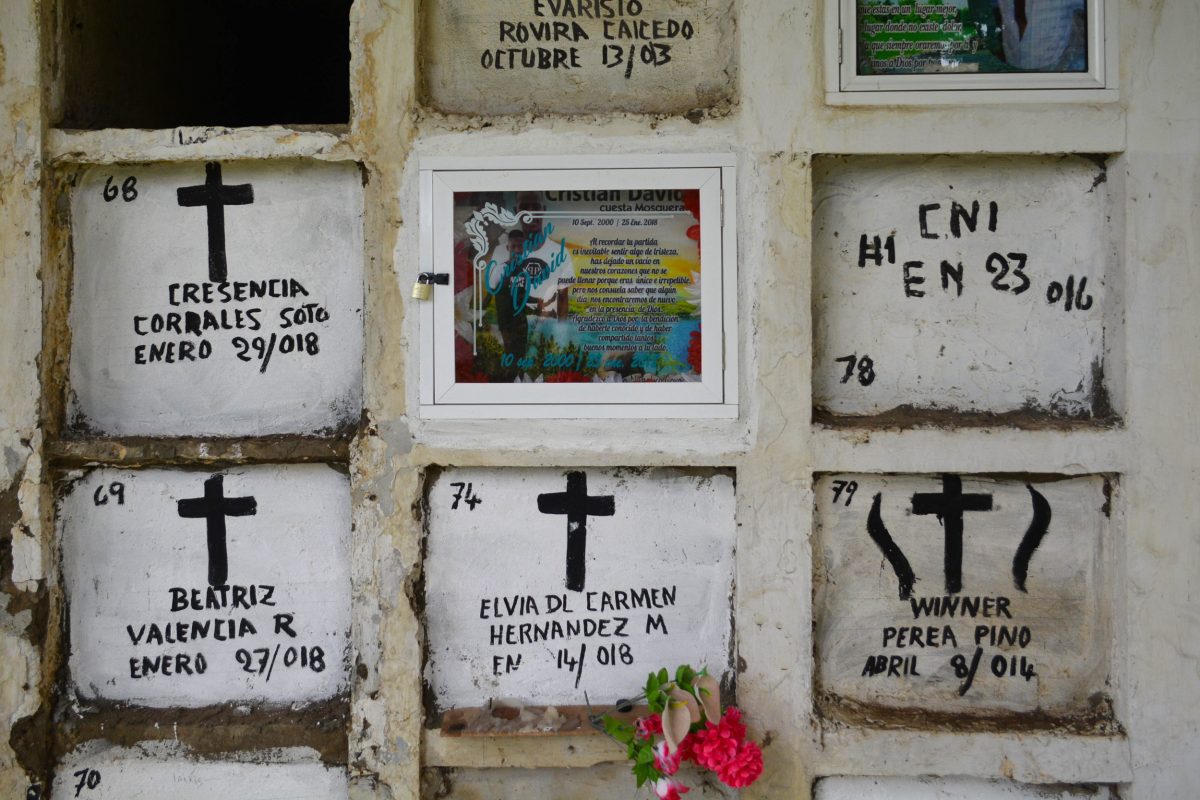
The letters CNI—for cuerpos no-identificados—mark the resting place of an unidentified individual in the main cemetery of Turbo. Photo by Sarah Tory
The sky is dark as we leave Turbo’s harbor. Speeding across the Golfo de Urabá on our way to Capurganá, the rugged coastline of the Darién Gap emerges: waves hurl themselves at the rocks jutting out from a jungle that spills into the sea. Wind flicks spray in our faces, and von Hoesslin mulls over the prevailing question, whose answer remains elusive: what happened to Davis? And what was the significance of the two mysterious male passengers who boarded the Victoria 168 days before he disappeared and of the women Davis had photographed aboard the Chung Kuo boats? Following their trail, Von Hoesslin stumbled into a reality far more complicated than he had imagined—a world in which Davis was likely only one casualty among many.
The region of Colombia surrounding the gulf, which spans two departamentos—Chocó and Antioquia—is controlled by one of Colombia’s most notorious drug cartels, El Clan del Golfo (the Gulf Clan), formerly called Los Urabeños. The group makes most of its money trafficking cocaine. It used to force coyotes transporting migrants through the territory to pay a tax: “If you don’t pay, you’re killed,” Fabricio Marín, the manager of a wharf in Turbo, told us before we left for Capurganá. But in 2016, when Cubans and Haitians began filing through en masse, the Gulf Clan became testy about migrants crossing the region and drawing too much attention to prized drug smuggling routes. The group responded by issuing an edict banning coyotes from bringing migrants from Turbo through the Darién Gap. Most of the older coyotes have since quit altogether, leaving much of the work to young members of local street gangs who saw a lucrative business opportunity transporting migrants through the cartel’s territory despite the risks.
In September 2016, two men and a woman from Cuba hired two coyotes (one of whom was a former member of the Gulf Clan) to smuggle them across the Panama border. In a boat near the mouth of the Río Atrato, across the gulf from Turbo, the coyotes demanded more money. When the Cubans told them they had no more, the coyotes stabbed the two men before tying them up and throwing their bodies overboard. One died while the other was seriously injured but survived by playing dead near the boat, where he witnessed the rape and murder of his girlfriend. He was rescued the next day by a fisherman.
While many migrants transiting through Ecuador on their way to the United States now arrive by air, some take the much longer, more arduous option of traveling by fishing boat. This animation depicts a rough approximation of how some migrants may be proceeding from China to Ecuador and beyond. Illustration by Mark Garrison/animation by Katrina Pyne
Arriving at the dock in Capurganá, we find a scrappy tourist town surrounded by a ruggedly beautiful landscape. Isolated coves lined with dark rocks and turquoise water are located a short walk from beachfront hotels. But beyond the facade of paradise, locals talk about the “crisis”—the influx of migrants that use Capurganá as a staging ground for their journey through the Darién Gap. Edgar Mejía, president of the local Afro-Colombian community council, says that the surge of migrants passing through Capurganá has overwhelmed local resources. He sees more trash in the rivers and streets now; new diseases; and sometimes, bodies in the jungle. A few weeks before we arrived, 62 US-bound migrants traveling by boat across the Golfo de Urabá were abandoned in the waters of Capurganá by coyotes who had promised to deliver them to Panama. One man drowned. Mejía worries about the pregnant women and the little kids most.
Underground migration has also transformed the local economy, bringing in new business for people like Raúl Peña, a restaurant owner in Capurganá. One afternoon, we sit with him around an outdoor table at his restaurant, Cruz del Mar, along a narrow street. The 30-year-old is also a lanchero, or boat driver, and takes tourists from Turbo to Capurganá. He used to take migrants too, sometimes as many as 50 at a time, charging each one 150,000 Colombian pesos (roughly US $45).
But two years ago, he quit. After the Gulf Clan tightened its grip, transporting migrants became too dangerous. “Everyone is afraid now,” he says.
Most of the other former and current coyotes working in Capurganá are too scared to talk to us, but Mejía thinks he knows one who will talk. We spend one night on the street in town, waiting for Mejía, who’s supposed to facilitate the meeting, to call. Hours pass without an update, and Mejía has stopped answering his phone. Another dead end. So the next day, we begin walking toward the jungle ourselves, hoping to at least talk to some migrants who might have made the journey from Ecuador. A row of brightly colored houses on the outskirts of Capurganá lead past an airstrip, which holds an abandoned plane once used for drug trafficking.
We see them almost immediately. A group of four young men, walking along the airstrip, all from Punjab, India, with wide eyes and bright smiles, bound for the United States where they plan on applying for asylum. Right now, they’re on their way back into town to buy food. Their journey has cost them each around $10,000—all arranged by a fixer in India—and it was going smoothly until they tried to cross the Darién Gap. They’ve failed to cross twice already. Both times, they were five days into their journey, within striking distance of the border, when Panama’s US-trained border patrol units appeared and their coyote abandoned them. Frightened to continue through the jungle alone, they returned to Capurganá. This time, they say, they will pay extra for the boat to Zapzurro. Despite the hardships they have endured, they are enthusiastic and energized about what lies ahead. It’s as if they’re on a grand life adventure instead of a journey across treacherous landscapes and dangerous border crossings—a journey that, for many, has ended in death.
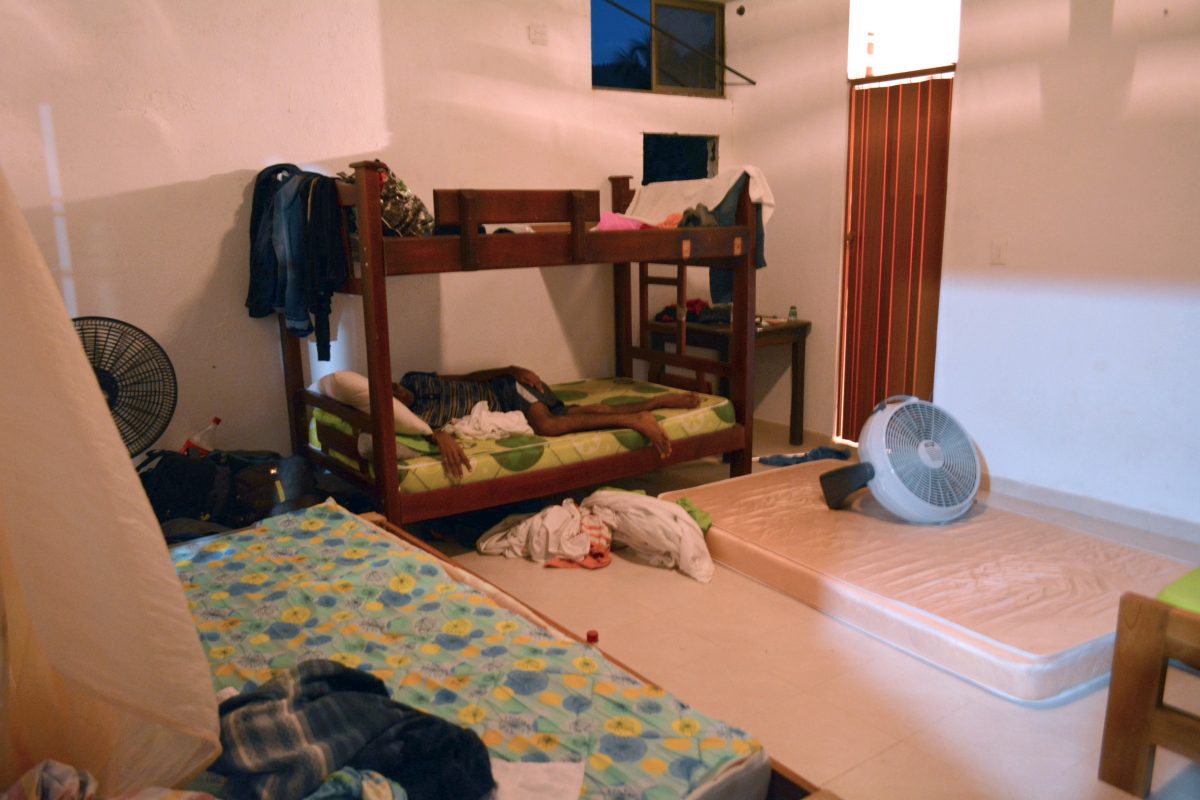
Low-budget hotels such as this one in Turbo cater entirely to migrants passing through on their way to the United States. Photo by Sarah Tory
We follow them back to their hostel, hoping to hear more about the details and logistics of their journey and to meet other migrants willing to share their stories. Hostal Los Acuarios, part of an underground network of accommodations catering entirely to migrants, is run by a woman named Lordis who charges the men $40 per night. On the second floor deck, where music is blaring, a 17-year-old from Sri Lanka with a boyish face shows me pictures from his own failed trek through the Darién Gap that he made with another group of migrants. The pictures show river crossings, close-ups of his arms covered in bug bites, and selfies with the other migrants deep in the jungle near la Loma de la Muerte, or “the hill of death,” a small mountain that takes migrants 12 hours to tackle on their way to Panama after several days of walking through the jungle.
Before we leave, one of the young Indian men we met on the airstrip gives me his number. Later, I try calling him multiple times, hoping to find out whether he and the others were able to reach Panama by boat. But he never answers, and I wonder if he and his friends are among the migrants who fell victim to the dangers of their journey. The sea is full of ghosts.
After Colombia, von Hoesslin and I part ways, and he travels to Vacamonte, Panama, the Victoria 168’s home base, hoping to question the two male Chinese passengers who had boarded just before Davis vanished. A contact in Panama’s immigration service had informed him that the men had been in Panama since May. But they left just days before von Hoesslin arrived—one on a ship bound for Sri Lanka and the other to an unknown location.
If he can’t convince Panamanian authorities—who continue to have jurisdiction over the case—to reopen the investigation into Davis’s disappearance, the case might forever disappear into bureaucracy. For von Hoesslin, it feels like his previous murder-at-sea case all over again—chasing suspects down from one corner of the globe to another for months or even years on end.
“I’m seeing now this is a déjà vu. … It’s a little depressing,” he says via text from Panama.
The US Coast Guard Investigative Service declined my request for an interview but explained in an email that the organization has no plans to pursue Davis’s case because it falls outside its purview.
Back in North America, von Hoesslin continues to mull over how to proceed. He had hoped to create a new niche of engaging the public to solve these types of cold cases, through crowdfunding, but his efforts have netted him only a few thousand dollars and his confidence, normally unshakable, has begun to waver. “People just don’t care,” he tells me. “So I’m not sure there’s a future.”
At moments, von Hoesslin feels like giving up. The investigation is depleting his savings, and he feels an urgency to get on with his life. The difficulties have left him needing a break. He’s spending more time on search and rescue work with his dog. But there’s Davis’s father, John, to think about. The Panamanian authorities treated his son’s disappearance as an accident instead of a criminal investigation, which devastated him.
The last observer log Davis recorded was dated September 8, 2015, though he generally wrote his entries one or two days after the posted date, which means his final log likely occurred the day he disappeared. After listing the date and the Victoria 168’s GPS coordinates, Davis wrote just two words—“The carrier”—and then nothing, as if something distracted him mid-sentence. Von Hoesslin found that detail strange. Davis was meticulous; it was unlike him to leave a job unfinished.

